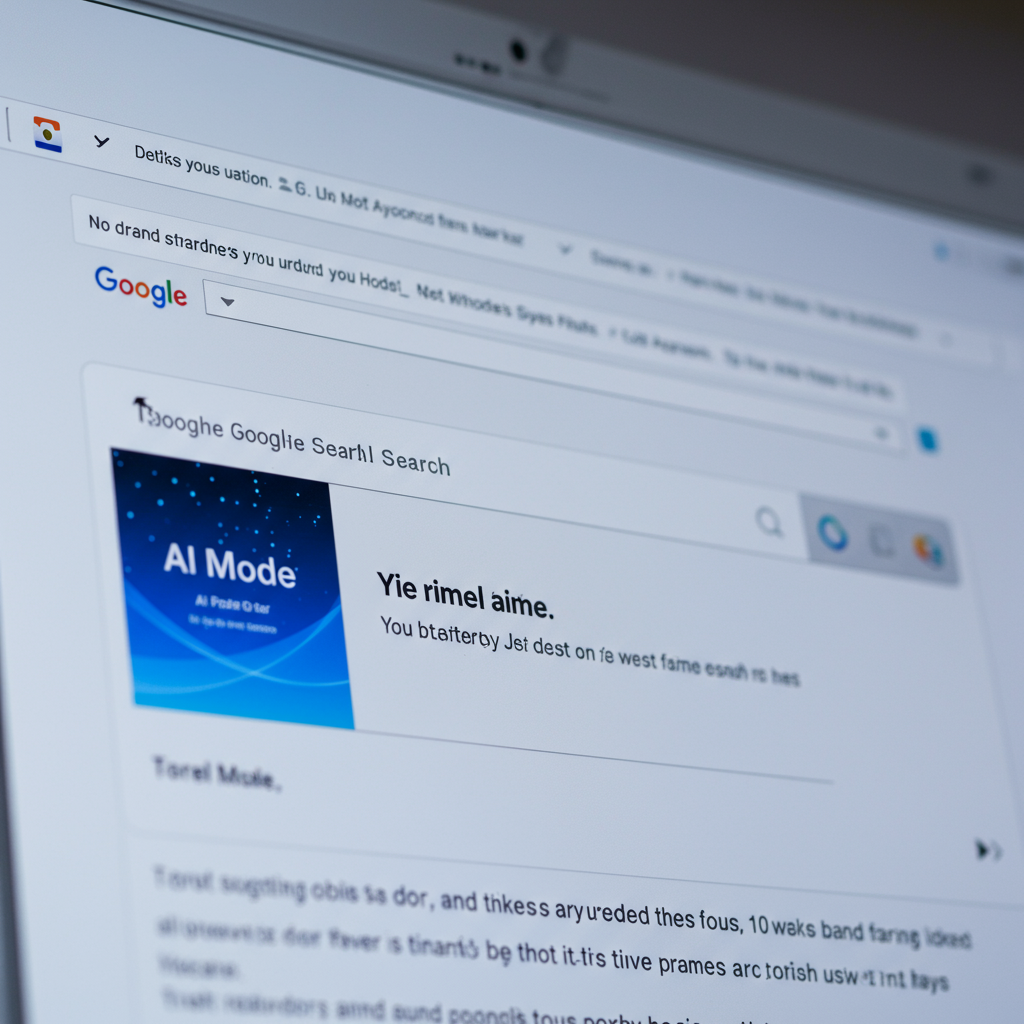In an unexpected move that highlights its intense focus on artificial intelligence, google recently transformed its highly valuable homepage – typically reserved for commemorative “Doodles” – into a promotional platform for its new AI-powered search feature, known as “AI Mode.” Launched on July 1st, 2025, this prominent placement across Google’s key surfaces signals a strategic push to accelerate user adoption and awareness of its latest AI advancements. This isn’t just a minor tweak; it represents a significant shift in how Google is introducing fundamental changes to its core search experience.
What is Google’s AI Mode?
At its core, Google’s AI Mode is designed to fundamentally change how users interact with search, especially for complex or multi-layered questions. Powered by Google’s advanced Gemini AI model, this feature moves beyond simply providing a list of links. Instead, it aims to offer comprehensive, AI-generated summaries and direct answers, doing the “heavy lifting” of information processing for the user. The goal is to simplify searches that previously might have required multiple queries and visits to different websites.
AI Mode is built for versatility. Users can submit queries using text, voice, or even images, leveraging its multi-modal capabilities. Since its initial integration alongside standard search results in March 2024 and later testing more prominent placement below the search bar in May 2025, AI Mode has been rolling out to more users, primarily within the United States. India is also a key market where testing is actively underway.
The Strategic Homepage Promotion
Google chose its most visited online real estate – the google.com homepage – to draw attention to AI Mode. This promotion featured a dynamic animation, which Google clarified is a “fun animation” to highlight the product rather than a traditional historical or cultural Doodle. This animation appeared across various platforms, including the main google.com homepage, the Google app, the Discover feed on mobile, and the Chrome New Tab page on Android, iOS, and desktop.
The visual presentation varied slightly depending on where it was viewed. On the Chrome New Tab page, users saw a still artwork featuring Google’s new gradient ‘G’ logo against a dark, sometimes space-like background. On the main homepage in the US (for both signed-in and logged-out users) and within the Google app and mobile Discover feed, a bouncy animation depicted the letters of the classic Google wordmark combining to form the gradient ‘G’ icon. This animation subtly symbolized how AI Mode aggregates and summarizes disparate pieces of information.
Beneath the standard search bar on the homepage, Google also used the space typically reserved for product promotion to display a clear call to action: “Try AI Mode and search like never before.” This tagline linked directly to google.com/aimode or initiated a search query specifically for “AI Mode,” directing users to the relevant AI Mode search results page. This dedicated page includes an AI Overview explaining the mode, often accompanied by the distinct Google-colored gradient design in the top-left corner or applied to the search results bar itself.
Why Did Google Use This Prime Real Estate?
While a Google spokesperson initially downplayed the homepage feature as merely a “fun promo,” experts and observers view this move as profoundly strategic. The decision to use the company’s most valuable digital space to promote a specific product, rather than commemorate an event, signals the immense stakes Google has placed in artificial intelligence and its future role in search.
This aggressive promotion is a direct response to the rapidly intensifying competition in the AI landscape. Startups like OpenAI (creators of ChatGPT), Anthropic (behind Claude), and Perplexity AI (an “AI-powered answer engine”) are challenging traditional search paradigms by offering direct, conversational AI interactions. Google needs to ensure its vast user base is not only aware of its own sophisticated AI capabilities but actively encouraged to use them.
The homepage animation and direct links are powerful tools for driving user awareness and accelerating adoption. They cut through the noise and present AI Mode front and center. Furthermore, reports indicate Google has even tested replacing the long-standing “I’m Feeling Lucky” button with a direct link to AI Mode, underscoring a fundamental reshaping of the core Google Search user experience. This isn’t just adding a feature; it appears to be an effort to redefine what searching on Google means.
Accessing and Exploring AI Mode
AI Mode was announced during the Google I/O 2025 conference and has been steadily rolling out. It is currently available to users in the United States and is undergoing testing in India. India is seen as a particularly strategic market for global rollout, given its vast user base, increasing tech-savviness, and affordable mobile data, all factors that could contribute to exponential adoption.
Users interested in trying the new AI Mode can typically find it within the Google Labs section. Access is provided by tapping the distinctive Beaker icon. On mobile devices using the Google app, this icon is usually located on the top-left. When using Google Search on a desktop, the beaker icon appears on the top-right. Upon entering Google Labs, users are often greeted with a “Meet AI Mode” prompt and a dialog box ready for their complex search queries.
Impact and Broader Implications
The introduction and prominent promotion of AI Mode have significant implications across various sectors. For web publishers and the media industry, this shift is particularly impactful. As AI Overviews and quick, synthesized answers become more common in search results, publishers face challenges regarding declining referral traffic, as users may no longer need to click through to external sites for basic information. This necessitates a rapid adaptation of content strategies, focusing on creating valuable, authoritative content that can still gain visibility or be referenced within AI-generated summaries.
User reception to AI Mode is currently mixed. Many users appreciate the potential for faster, more organized access to information and the convenience of getting direct answers without navigating multiple pages. However, concerns are also raised about the accuracy and reliability of AI-generated summaries, the potential for AI bias to influence information flow, and whether relying solely on synthesized answers could reduce critical thinking skills or limit exposure to diverse perspectives.
Beyond user experience, AI Mode raises broader social, ethical, and regulatory questions. Issues of data privacy, the potential for spreading misinformation via confident but incorrect AI answers, and the concentration of information power within a few tech giants are subjects of ongoing debate. Governments and regulatory bodies worldwide are grappling with establishing frameworks for AI governance, such as the EU’s proposed AI Act, to address these complex challenges.
The Future of Search
Google’s AI Mode promotion is more than just a marketing push; it’s a glimpse into the potential future of search. The company is already working on expanding AI Mode’s capabilities, including features like “Search Live” (allowing verbal interaction), a future camera mode for visual queries, “Deep Search” for more comprehensive analysis, and integration with personal context from services like Gmail. Agentic capabilities, enabling the AI to perform tasks like finding and purchasing tickets, are also on the horizon.
This evolution positions AI as an intelligent assistant within the search experience, capable of understanding nuanced intent and integrating with other services. While AI Mode promises users efficiency and simplified information access by performing the “heavy lifting,” it simultaneously requires significant adaptation from competing AI services, web publishers, and society at large to navigate this evolving AI-first information environment. The strategic use of the homepage confirms Google’s commitment to making AI Mode a cornerstone of its future.
Frequently Asked Questions
What is the main benefit of using Google’s AI Mode for search?
The primary benefit of Google’s AI Mode is its ability to provide comprehensive, AI-generated summaries and direct answers to complex or multi-layered questions. Instead of presenting users with a list of links, AI Mode, powered by Gemini, synthesizes information from various sources to offer organized, easy-to-digest breakdowns directly in the search results. This is intended to save users time and effort by reducing the need for multiple searches or visiting numerous websites.
How can I access and try out Google’s AI Mode?
Users can typically access Google’s AI Mode through the Google Labs section within the Google app or on the google.com website. To find it, look for a Beaker icon. On the Google mobile app, the beaker icon is usually in the top-left corner. When using Google Search on a desktop, the beaker icon is typically in the top-right corner. Clicking the beaker icon leads you to Google Labs, where you can find the “Meet AI Mode” prompt and begin entering your queries. AI Mode is currently available in the US and testing in India.
Why did Google use its homepage to promote AI Mode instead of a traditional Doodle?
Google’s decision to use its iconic homepage, a space usually reserved for commemorating historical and cultural events via Doodles, to promote AI Mode highlights the strategic importance and immense investment Google has placed in this AI feature. While Google described it as a “fun animation,” the move is widely seen as a powerful effort to accelerate user awareness and adoption amid intense competition from other AI startups. It signals that AI Mode is a core part of Google’s future search strategy, requiring maximum visibility.
The strategic promotion on the homepage signifies Google’s belief that AI Mode represents the next evolution of search. By leveraging its most prominent digital asset, Google aims to quickly familiarize its vast user base with AI Mode and encourage its widespread adoption. This is seen as a critical step in solidifying its position in the competitive landscape dominated by artificial intelligence.




